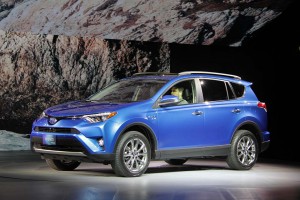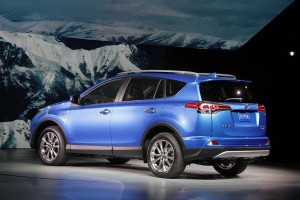
The 2016 Toyota RAV4 hybrid will post class-leading mileage numbers, officials said during its New York Auto Show debut.
Toyota has rolled out the latest in a growing family of hybrid vehicles during the New York International Auto Show next week, the 2016 RAV4 Hybrid.
The Japanese maker’s eighth gas-electric model adopts relatively subtle tweaks to differentiate itself from other versions of the RAV4 crossover-utility vehicle, including modest revisions to the front end. But it opts for the most radical revision yet of the familiar Toyota Synergy Drive powertrain.
The introduction might not be seen as the best timing for a new hybrid. With a few rare exceptions, the market for battery-based vehicles has taken a sharp tumble over the last year – even the Prius losing momentum in 2014 – as a result of lower gas prices. But Toyota remains optimistic there will be solid demand for what Bill Fay, head of the Toyota division, calls a “no compromise SUV.”
Unlike models like the Prius, which pair two electric motors with a gasoline engine, the RAV4 Hybrid adds a third motor to drive the rear axle. It kicks in “only when additional torque is needed,” explained Fay, during a NY news conference.

The new 2016 RAV4 hybrid uses a system with an electric motor on the rear axle only that kicks in "only when necessary."
That approach is sometimes referred to as a through-the-road hybrid and is expected to become increasingly common in the years to come. It eliminated the central driveshaft, trimming weight and complexity.
All 2016 Toyota RAV4 Hybrid versions sold in the U.S. will be equipped with the electric AWD system.
(Toyota and Lexus to introduce low-cost braking systems. For more, Click Here.)
Buyers, meanwhile, will be able to order one of two new packages of collision-avoidance technologies, at prices ranging from $300 to $500. The basic one, dubbed Toyota Safety Sense C, will include three technologies:
- Pre-collision System, or PCS. Using a camera and laser radar, it can detect a potential frontal collision, initially alerting the driver. If no action is taken, it can apply the brakes to either prevent, or at least reduce the severity of, a crash;
- Lane Departure Alert, or LDA, uses a camera to detect when a vehicle starts to drift out of its lane, sounding an alert to get the driver to regain control;
- Automatic High Beam, or AHB, also uses a camera, in this case to detect oncoming vehicles and the taillights of vehicles ahead, automatically switching the high beams on and off.
The Toyota Safety Sense P package adds several more features, including Pedestrian Pre-Collision capabilities. As with the basic PCS system, it can spot pedestrians who might be in the vehicle’s path, sounding an alert or, if necessary, applying the brakes automatically.
(Click Here for details about Toyota’s confirmation of a new hybrid RAV4.)
The debut of the RAV4 Hybrid shows Toyota is bound and determined to stick with its oft-stated goal of offering a hybrid version of every volume car in its catalog by the end of the decade.
Redesigned for the 2012 model-year, the RAV4 is one of Toyota’s most popular models, setting an all-time annual sales record in 2014, so even with a small share of buyers opting for the new version that could deliver a big bump in the Japanese maker’s overall hybrid sales volume.
(To see more about Nissan’s possible new U.S. plant, Click Here.)
Currently, there are few other options for green-minded buyers in the compact crossover segment. Ford abandoned the hybrid version of its Escape when it redesigned that CUV several years ago.
Toyota did not release horsepower or mileage numbers for the 2016 RAV4 Hybrid, but Fay declared, “Mark my words, the Hybrid will have segment-leading fuel economy.”
